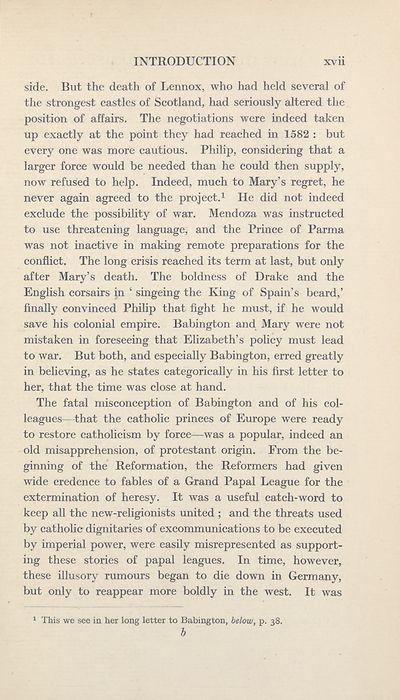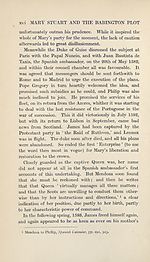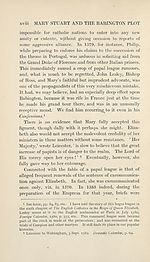Series 3 > Mary Queen of Scots and the Babington plot
(22) Page xvii
Download files
Complete book:
Individual page:
Thumbnail gallery: Grid view | List view

INTRODUCTION
xvn
side. But the death of Lennox, who had held several of
the strongest castles of Scotland, had seriously altered the
position of affairs. The negotiations were indeed taken
up exactly at the point they had reached in 1582 : but
every one was more cautious. Philip, considering that a
larger force would be needed than he could then supply,
now refused to help. Indeed, much to Mary’s regret, he
never again agreed to the project.1 He did not indeed
exclude the possibility of war. Mendoza was instructed
to use threatening language, and the Prince of Parma
was not inactive in making remote preparations for the
conflict. The long crisis reached its term at last, but only
after Mary’s death. The boldness of Drake and the
English corsairs in ‘ singeing the King of Spain’s beard,’
finally convinced Philip that fight he must, if he would
save his colonial empire. Babington and Mary were not
mistaken in foreseeing that Elizabeth’s policy must lead
to war. But both, and especially Babington, erred greatly
in believing, as he states categorically in his first letter to
her, that the time was close at hand.
The fatal misconception of Babington and of his col¬
leagues—that the catholic princes of Europe were ready
to restore Catholicism by force—was a popular, indeed an
old misapprehension, of protestant origin. From the be¬
ginning of the Reformation, the Reformers had given
wide credence to fables of a Grand Papal League for the
extermination of heresy. It was a useful catch-word to
keep all the new-religionists united ; and the threats used
by catholic dignitaries of excommunications to be executed
by imperial power, were easily misrepresented as support¬
ing these stories of papal leagues. In time, however,
these illusory rumours began to die down in Germany,
but only to reappear more boldly in the west. It was
1 This we see in her long letter to Babington, below, p. 38.
b
xvn
side. But the death of Lennox, who had held several of
the strongest castles of Scotland, had seriously altered the
position of affairs. The negotiations were indeed taken
up exactly at the point they had reached in 1582 : but
every one was more cautious. Philip, considering that a
larger force would be needed than he could then supply,
now refused to help. Indeed, much to Mary’s regret, he
never again agreed to the project.1 He did not indeed
exclude the possibility of war. Mendoza was instructed
to use threatening language, and the Prince of Parma
was not inactive in making remote preparations for the
conflict. The long crisis reached its term at last, but only
after Mary’s death. The boldness of Drake and the
English corsairs in ‘ singeing the King of Spain’s beard,’
finally convinced Philip that fight he must, if he would
save his colonial empire. Babington and Mary were not
mistaken in foreseeing that Elizabeth’s policy must lead
to war. But both, and especially Babington, erred greatly
in believing, as he states categorically in his first letter to
her, that the time was close at hand.
The fatal misconception of Babington and of his col¬
leagues—that the catholic princes of Europe were ready
to restore Catholicism by force—was a popular, indeed an
old misapprehension, of protestant origin. From the be¬
ginning of the Reformation, the Reformers had given
wide credence to fables of a Grand Papal League for the
extermination of heresy. It was a useful catch-word to
keep all the new-religionists united ; and the threats used
by catholic dignitaries of excommunications to be executed
by imperial power, were easily misrepresented as support¬
ing these stories of papal leagues. In time, however,
these illusory rumours began to die down in Germany,
but only to reappear more boldly in the west. It was
1 This we see in her long letter to Babington, below, p. 38.
b
Set display mode to:
![]() Universal Viewer |
Universal Viewer | ![]() Mirador |
Large image | Transcription
Mirador |
Large image | Transcription
Images and transcriptions on this page, including medium image downloads, may be used under the Creative Commons Attribution 4.0 International Licence unless otherwise stated. ![]()
| Scottish History Society volumes > Series 3 > Mary Queen of Scots and the Babington plot > (22) Page xvii |
|---|
| Permanent URL | https://digital.nls.uk/127234305 |
|---|
| Attribution and copyright: |
|
|---|
| Description | Over 180 volumes, published by the Scottish History Society, containing original sources on Scotland's history and people. With a wide range of subjects, the books collectively cover all periods from the 12th to 20th centuries, and reflect changing trends in Scottish history. Sources are accompanied by scholarly interpretation, references and bibliographies. Volumes are usually published annually, and more digitised volumes will be added as they become available. |
|---|


